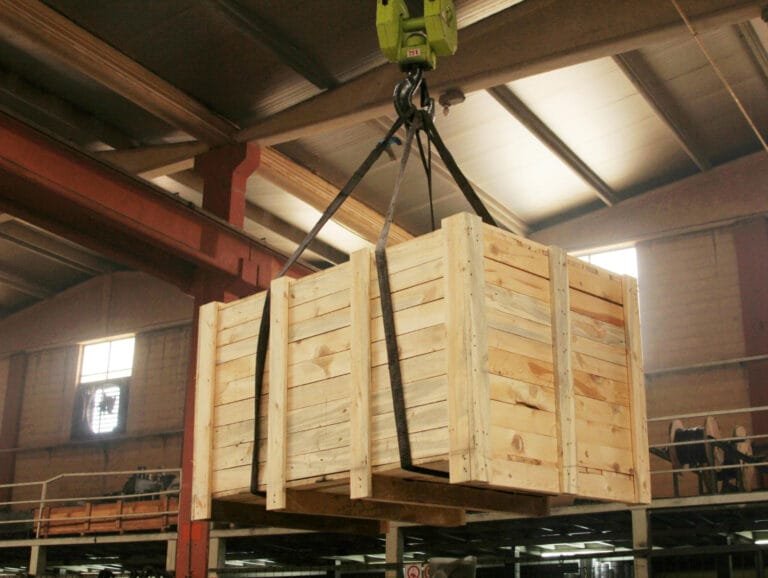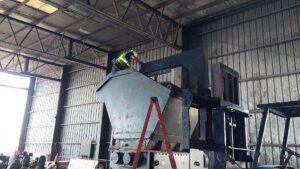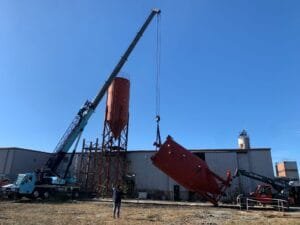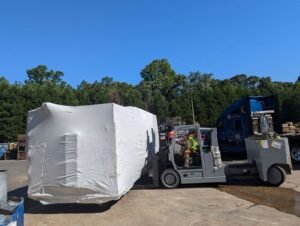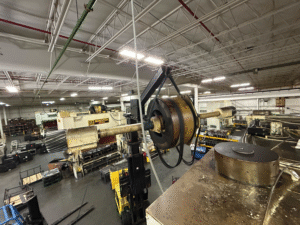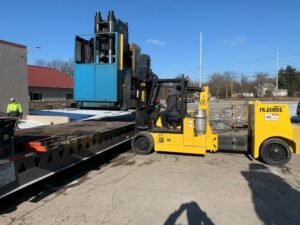When it comes to shipping, relocating, or storing industrial equipment, the importance of proper crating cannot be overstated. From heavy machinery to sensitive electronic components, industrial goods often face harsh conditions in transit—shock, vibration, temperature fluctuations, and the risk of physical damage. That’s why custom, secure, and professionally built crates are a must.
But should you manage crating in-house or outsource to professionals? For many businesses, outsourcing industrial crating services offers a smarter, faster, and more cost-effective solution. In this article, we’ll explore the many reasons why outsourcing crating is a strategic move, how it works, the types of services offered, and what to look for in a crating partner.
What Is Industrial Crating?
Industrial crating involves designing, constructing, and assembling custom shipping containers or protective enclosures for industrial goods. These crates are built to secure products during transportation, handling, and storage. Crating solutions often include:
-
Custom wood or metal frames
-
Shock-absorbing interior supports
-
Moisture and corrosion protection
-
Foam, blocking, bracing, or VCI (volatile corrosion inhibitors)
-
ISPM 15 heat-treated compliance for exports
Whether your equipment weighs 200 lbs or 200 tons, industrial crating protects your investment from point A to point B.
In-House vs. Outsourced Crating: What’s the Difference?
In-House Crating
-
Done by your own employees using internal tools and materials
-
Requires floor space, time, training, and compliance know-how
-
Often lacks custom design or engineering
Outsourced Crating
-
Handled by third-party professionals
-
Includes design, materials, fabrication, on-site or off-site assembly
-
May also include packaging, shipping coordination, and documentation
Outsourcing gives you access to specialized skills and scalable support, without tying up internal resources.
Why Outsourcing Crating Makes Business Sense
Let’s break down the top reasons why industrial companies are increasingly choosing to outsource their crating needs:
Expertise You Can Rely On
Crating companies specialize in transport protection. They understand the physics of movement, the engineering required to support irregular loads, and the regulations involved in domestic and international shipping.
Outsourcing gives you access to:
-
Engineers with CAD software for custom crate designs
-
Experts in ISPM-15 export standards
-
Proper load balancing and bracing strategies
-
Proven packaging solutions for high-value equipment
Rather than guessing how to secure a $100,000 machine, you can leave it to professionals who do it every day.
Time Savings and Faster Deployment
Crating takes time—especially if you don’t have a dedicated team or materials readily available. Outsourcing can cut days or even weeks off your shipping schedule.
-
Crating vendors stock materials in bulk
-
They can pre-fabricate or crate on-site quickly
-
Their crews are experienced and efficient
This allows your team to focus on your project—not on building crates.
Lower Labor and Overhead Costs
Building crates in-house means training workers, managing OSHA compliance, purchasing tools, and dedicating floor space.
Outsourcing removes all of that:
-
No need for skilled crating labor
-
No investment in saws, nail guns, or materials
-
No disruptions to your production floor
You pay only for the service you need—when you need it.
Better Protection and Fewer Damages
Improper crating is a leading cause of freight damage, and damage means:
-
Lost revenue
-
Insurance claims
-
Customer dissatisfaction
-
Rework or delays
Professional crating services reduce the risk of damage by using:
-
Structural-grade lumber and steel
-
Impact-absorbing foams and blocking
-
Precision cuts and load analysis
-
Moisture barriers and corrosion inhibitors
This ensures that your equipment arrives safely—no surprises.
Scalable to Project Size and Location
Whether you’re shipping one machine a year or 500, outsourced crating services can scale up or down based on your volume.
-
Need 10 identical crates for overseas shipments? Done.
-
Need one massive custom crate for an odd-shaped turbine? Also done.
-
Need on-site crating at a job site? They’ll come to you.
Crating vendors often serve regional or national territories, allowing consistent service across multiple locations.
Compliance with Export Regulations
Exporting industrial goods means complying with international standards—especially ISPM 15, which requires wood packaging to be heat-treated and stamped.
Professional crating providers:
-
Use certified ISPM 15 wood
-
Stamp crates with compliance codes
-
Prepare proper documentation for customs clearance
Failing to comply can lead to border delays, fines, or rejections. Outsourcing ensures everything is handled correctly the first time.
Integrated Logistics and Packaging Services
Many crating companies offer more than just crating—they can handle:
-
Machinery disassembly or prep
-
Palletizing and shrink-wrapping
-
Loading and securing into containers
-
Transportation coordination
This reduces the need to work with multiple vendors and gives you a single point of contact for your entire shipping process.
Use Cases Where Outsourcing Makes the Most Impact
Outsourced crating is valuable in many industrial scenarios, especially:
– Equipment Relocation Projects
When moving a facility or installing machinery across sites.
– International Exports
For shipping to countries with strict customs and packaging laws.
– Trade Shows and Exhibits
When equipment needs secure, reusable transport and display crates.
– Job Site Deliveries
Heavy or bulky items crated and protected for construction or plant sites.
– Emergency Shipments
Expedited crating needed for replacement parts or critical downtime situations.
Types of Crating Services Available
Depending on your needs, outsourced crating providers offer a range of solutions:
Custom Wooden Crates
-
Built to exact dimensions and weight specs
-
With bracing, foam lining, and shock support
Reusable Crates
-
Heavy-duty containers with removable lids
-
Ideal for rotating assets or repeated use
Skids and Pallets
-
Base platforms for easier handling and transport
-
Can include bolting or securing mechanisms
Export Crates
-
ISPM 15 certified
-
Designed for overseas shipment and customs compliance
Vapor Barrier Packaging
-
For sensitive electronics or moisture-prone equipment
-
Includes desiccants, shrink wrap, or Mylar covers
On-Site Crating
-
Crews arrive at your location to build or pack
-
Minimizes equipment movement and risk
The bottom line? Outsourcing is often more cost-effective, efficient, and reliable, especially when scaled.
How to Choose the Right Crating Partner
When looking for a crating service provider, consider these criteria:
✅ Experience in Your Industry
Have they crated similar equipment before? Can they handle the weight, dimensions, and fragility of your assets?
✅ Certifications
Are they ISPM 15 certified? Do they follow OSHA and DOT safety standards?
✅ Design and Engineering Capabilities
Can they custom design crates using CAD software and load specs?
✅ Mobile and On-Site Services
Are they flexible enough to send crews to your plant or job site?
✅ Insurance and Liability Coverage
Are they insured to cover damage or loss during crating and handling?
✅ Customer Support
Do they offer fast response times, updates, and professional documentation?
Myths About Outsourcing Crating—Debunked
❌ “It’s too expensive.”
In reality, you often save money when considering time, labor, tools, materials, and risk reduction.
❌ “I lose control.”
Reputable vendors provide full documentation, specs, and pre-approval of designs. You’re involved every step of the way.
❌ “I can just wrap it in shrink film.”
Shrink wrapping is great—but not for 5,000 lb equipment heading overseas. Crating is structural, protective, and compliant.
The Future of Industrial Crating
The crating industry is embracing technology, sustainability, and precision. Look for trends like:
-
3D modeling and virtual crate prototyping
-
Reusable crates with RFID tracking
-
Recycled and sustainable wood products
-
Predictive load analysis for better protection
-
Integration with logistics platforms
Outsourcing to a tech-savvy crating provider means fewer headaches and better results as logistics become more complex.
Final Thoughts
In an age of fast-moving supply chains, rising labor costs, and global shipping complexity, outsourcing industrial crating is not just a convenience—it’s a smart business decision.
It gives you access to experienced professionals, protects your valuable equipment, and frees up your internal teams to focus on what they do best. From efficiency and cost-savings to compliance and peace of mind, outsourcing delivers clear value.
Whether you’re preparing for a large export shipment or relocating plant machinery, consider partnering with a crating specialist to ensure everything arrives safe, secure, and ready to perform.
Alltracon: Industrial Crating You Can Count On
Alltracon provides expert industrial crating solutions tailored to your equipment and shipping requirements. From custom-designed export crates to on-site crating and packaging, we handle everything with precision and care. Trust Alltracon to protect what moves your business—safely, efficiently, and on time.
